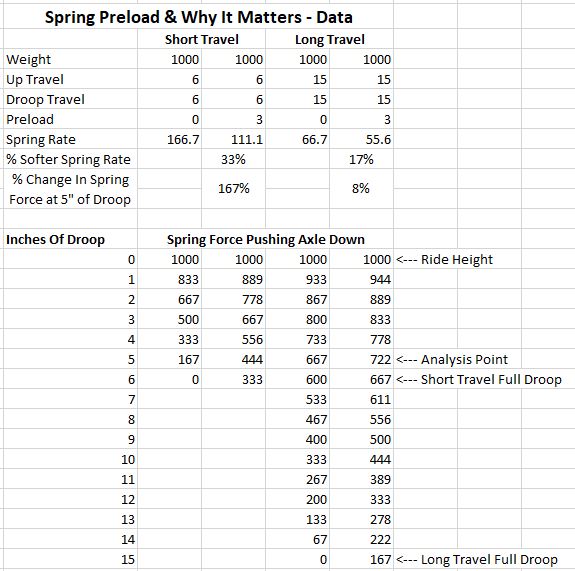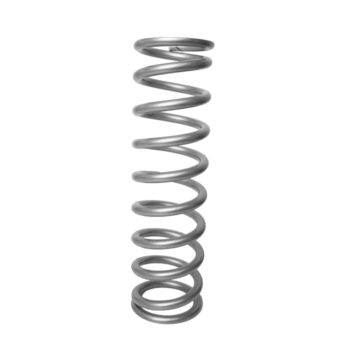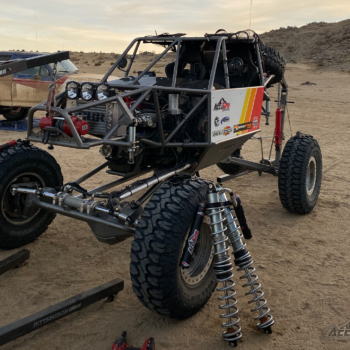Spring Preload & Why it Matters
Spring preload is an important, but often misunderstood concept and this article is going to clear things up.
How To Measure Preload:
Preload refers to how much the spring is compressed when the shock is fully extended. To set it, thread the upper spring adjuster down until it just contacts the spring—this is considered 0″ of preload. Each additional inch you thread it down adds 1″ of preload.
With a 1.0 motion ratio, 1″ of preload raises the vehicle by 1″. With a 0.5 motion ratio, that same 1″ of preload lifts the vehicle by 2″.
If you need more lift but already have the correct preload, you’ll need stiffer springs.
If you want less lift, you’ll need softer springs.
Preload & Spring Length:
Preload is independent of spring free length. For example, an 18″ long spring with a rate of 100 lb/in and 1″ of preload will produce the same ride height as a 10″ long spring with the same 100 lb/in rate and 1″ of preload.
In both cases, 100 pounds of force is applied before the vehicle’s weight compresses the spring. Since the spring rates are identical, both springs compress the same amount under load, resulting in the same ride height.
Spring length only becomes a factor if there isn’t enough threaded adjustment on the shock to achieve the required preload, or if the spring risks reaching coil bind under compression.
Why Do We Need Preload:
Most people focus on what happens when springs compress, but it’s just as important to consider what happens when they extend. Preload doesn’t just support the vehicle—it also pushes the tires downward, helping the suspension stay active.
At speed, over large bumps or rough terrain, preload helps the tires extend quickly to maintain contact with the ground, resulting in a smoother and more controlled ride. During articulation, preload increases tire contact pressure, which improves traction when it’s needed most.
Why Do People Say: “Springs Just Hold The Vehicle Up”:
“Springs just hold the vehicle up” is a phrase often repeated in the off-road world, especially among those working with long-travel race trucks. In those setups—with 15 inches or more of droop—the springs are typically very soft, and adjusting preload has minimal effect on spring force.
However, in shorter-travel suspensions—say, with around 6 inches of droop—the same change in preload results in a much more significant increase in spring force.
As shown in the graph below:
-
A long-travel desert truck going from 0″ to 3″ of preload only sees about an 8% increase in spring force at 5″ of droop.
-
A shorter-travel vehicle experiences a 167% increase in spring force from that same preload change.
This demonstrates that precise preload tuning becomes far more critical in short- and mid-travel suspension setups. While the “springs just hold the vehicle up” mindset may apply in the long-travel world, it simply doesn’t hold true for more typical suspension designs.
Can You Have Too Much Preload?
Springs function in both compression and extension, and too much preload can make the springs too soft during compression. When this happens, we often have to adjust the shock valving to compensate, but this can sometimes lead to increased harshness in the ride.
We view the suspension system as a complete package—each component has a specific role, and everything must work in harmony. When preload is excessive, the springs aren’t able to do their part effectively, which compromises the overall performance of the suspension.
How Much Preload Should I Have?
For most applications, starting with 1″ of preload in the front and 2″ of preload in the rear is a good baseline. However, when you purchase springs from us, we take additional factors into account to ensure you have the ideal spring rate. Because of this, we sometimes adjust or break from this guideline.
Some vehicle-specific applications have unique preload requirements. For example, Toyota Tacomas and 4Runners generally require 2″ of preload in the front. With standard aftermarket 600 lb/in springs, there is some adjustability in the coilovers. However, for heavier Toyotas, you’ll need to install 650 lb/in or 700 lb/in springs to achieve the correct ride height. When these heavier springs are installed, the preload adjustability is substantially reduced. There’s limited room on the body to reduce preload, and going beyond the optimal preload can cause the springs to coil bind.
Therefore, choosing the right springs for the weight and lift height of your Tacoma or 4Runner is crucial. The good news is we’re here to help you select the perfect springs, and we offer free spring swapping if the rate isn’t quite right.
Summary:
Spring preload is especially important on shorter-travel vehicles. To ensure optimal performance, it’s essential to buy springs from a company that offers free and unlimited spring swapping, like AccuTune Offroad. While 1″ of preload in the front and 2″ in the rear is a great starting point, some suspension systems may require adjustments that break the standard “rules.”
Give us a call for all your spring needs—we’re here to help!













